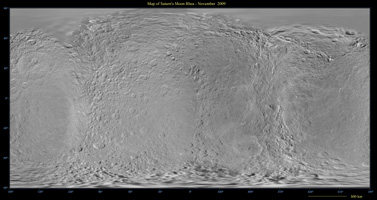
Annotated image
Click on the image for larger versionThis global digital map of Saturn's moon Rhea was created using data obtained by NASA's Cassini and Voyager spacecraft.
The map is an equidistant projection and has a scale of 417 meters (1,400 feet) per pixel in the full size version. The mean radius of Rhea used for projection of this map is 764.1 kilometers (474.8 miles).
This map is an update to the version released in February 2010 (see PIA12561). The title of that older version ("Map of Rhea - February 2010") denotes the month the map was released, not when the data in the map were collected. The title of this new version reflects when the most recent data used in the map were captured. The newest data were used to improve coverage north of the equator between about 250 degrees west longitude and 300 degrees west longitude.
Six Voyager images fill gaps in Cassini's coverage of the north pole.
The Cassini-Huygens mission is a cooperative project of NASA, the European Space Agency and the Italian Space Agency. The Jet Propulsion Laboratory, a division of the California Institute of Technology in Pasadena, manages the mission for NASA's Science Mission Directorate in Washington. The Cassini orbiter and its two onboard cameras were designed, developed and assembled at JPL. The imaging team is based at the Space Science Institute, Boulder, Colo.
For more information about the Cassini-Huygens mission visit http://saturn.jpl.nasa.gov/. The Cassini imaging team homepage is at http://ciclops.org.

